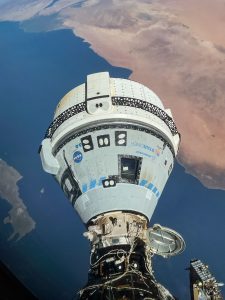Politics
NEW: NASA Astronauts ‘Stranded’ On Boeing Spacecraft
Two NASA astronauts are still orbiting Earth on the International Space Station, two weeks past their scheduled return.
Barry “Butch” Wilmore and Suni Williams remain on the ISS as Boeing and NASA engineers work to fix helium leaks on the Boeing Starliner spacecraft, which ferried them on its first crewed voyage. The spacecraft continues to experience malfunctions, delaying their return. NASA and Boeing managers have decided to extend the Starliner crew capsule’s stay at the ISS.
They passed up a June 26 re-entry to allow more time for analysis and testing to understand the helium leaks and thruster failures fully, officials announced late Friday. NASA plans to hold a formal re-entry readiness review before setting a new landing target date. Given the ongoing analysis, the Starliner’s undocking and return to Earth will likely be delayed at least another week.
Officials have claimed that they are not stranded in orbit. “We are taking our time and following our standard mission management team process,” Steve Stich, manager of NASA’s Commercial Crew Program, said in a statement according to CBS News. “We are letting the data drive our decision-making relative to managing the small helium system leaks and thruster performance we observed during rendezvous and docking.”
#NASA crewed mission liftoff this morning as viewed in hi-res #GOES #NESDIS visible (Ch 2) imagery. pic.twitter.com/FLSnRcx3OD
— NWS State College (@NWSStateCollege) June 5, 2024
He also noted that because of the Starliner mission’s extended duration, “it is appropriate for us to complete an agency-level review, similar to what was done ahead of NASA’s SpaceX Demo-2 return after two months in orbit, to document the agency’s formal acceptance on proceeding as planned.” He was referring to the initial astronaut flight on SpaceX’s Crew Dragon ferry ship in 2020. Unlike the Starliner’s first crewed test flight, the Demo-2 mission did not face the same issues.
The Starliner, attached to a drum-shaped service module at the base of the crew capsule, faces challenges with helium leaks and thruster issues. The service module, crucial for the spacecraft’s operations, is discarded before re-entry and incinerates in the atmosphere, preventing engineers from examining the actual hardware afterward.
CAST YOUR VOTE: Should Voter ID Be Mandatory In The 2024 Election?

(June 13, 2024) — The Starliner spacecraft on NASA’s Boeing Crew Flight Test is pictured docked to the Harmony module’s forward port as the International Space Station orbited 263 miles above the Mediterranean Sea.
Due to this limitation, NASA and Boeing managers are keen to provide their engineering team ample time to analyze telemetry data, conduct further tests, and refine emergency plans for potential issues that may arise post-undocking.
The Starliner, officially known as the CST-100 Starliner, is a class of spacecraft developed by Boeing. It’s designed for NASA’s Commercial Crew Program to transport astronauts to and from the International Space Station (ISS). The Starliner is part of NASA’s effort to use spacecraft developed through partnerships with private aerospace companies.
Already delayed by four years, the ship’s journey has faced setbacks including a month-long delay caused by minor issues with its Atlas 5 rocket, a countdown computer malfunction, and an initial helium leak in the system that pressurizes the thrusters. Despite complications, NASA and Boeing decided the initial leak was minor and did not compromise safety, allowing the Starliner to launch on June 5.
However, once in orbit en route to the space station, the situation worsened with four new helium leaks. The spacecraft’s flight computer responded by deactivating seven maneuvering jets when telemetry readings failed to meet pre-launch expectations. A subsequent “hot-fire” test last Saturday proved successful, restoring confidence that the remaining jets could handle essential maneuvers and the critical de-orbit burn needed for re-entry.
Meanwhile, this has not been the year for Boeing. The company has been dealing with several controversies and setbacks which have significantly impacted its operations and public perception. Boeing has faced a series of safety issues that have led to accusations of the company stonewalling investigations and not providing necessary documentation to the National Transportation Safety Board (NTSB).
(ALERT: Biden’s New Executive Order Will Crush The US Dollar For Good)

